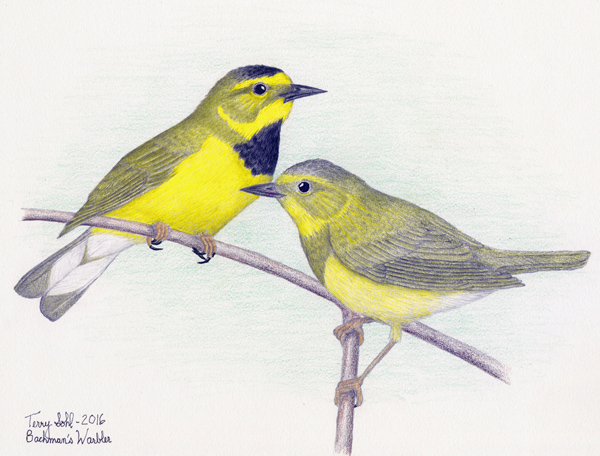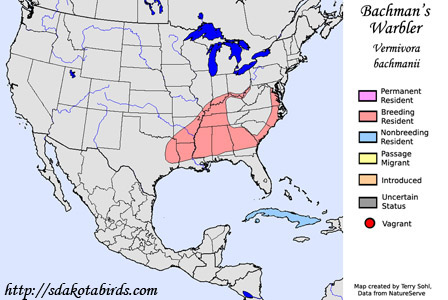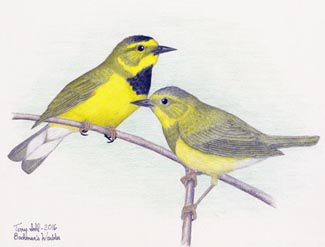| Length: 4.25 inches | Wingspan: 7.25 inches | Seasonality: Non-resident in South Dakota |
| ID Keys:Yellow below, olive green above, with dark "bib" on males and dark crown patch, thin slightly decurved bill | ||
 Extinct
or alive? Most ornithologists would likely state that we've forever
lost the Bachman's Warbler. The last confirmed breeding was around
1937, and the last confirmed sighting was in 1988 in Louisiana. The
last "collections" of the species occurred in the early 1940s.
However, hope remains for many that the Bachman's Warbler has managed to
hang on, and there have been a number of unconfirmed sightings over the
years. A
video taken in Cuba in January 2002 may have shown an immature female
Bachman's Warbler. The Congaree Swamp in South Carolina is noted as a
location where suitable breeding habitat likely remains, and the
inaccessible nature of much of the area makes it possible that a remant
population of Bachman's Warblers has managed to survive there. An
amateur birder reported hearing and seeing a male and female Bachman's
warbler in the Congaree in 2002. While
follow up
searches deemed that the area deserves additional scrutiny as a possible
holdout for the species, they also declared that it is unlikely to be found there anymore.
Extinct
or alive? Most ornithologists would likely state that we've forever
lost the Bachman's Warbler. The last confirmed breeding was around
1937, and the last confirmed sighting was in 1988 in Louisiana. The
last "collections" of the species occurred in the early 1940s.
However, hope remains for many that the Bachman's Warbler has managed to
hang on, and there have been a number of unconfirmed sightings over the
years. A
video taken in Cuba in January 2002 may have shown an immature female
Bachman's Warbler. The Congaree Swamp in South Carolina is noted as a
location where suitable breeding habitat likely remains, and the
inaccessible nature of much of the area makes it possible that a remant
population of Bachman's Warblers has managed to survive there. An
amateur birder reported hearing and seeing a male and female Bachman's
warbler in the Congaree in 2002. While
follow up
searches deemed that the area deserves additional scrutiny as a possible
holdout for the species, they also declared that it is unlikely to be found there anymore.
Habitat destruction is most often blamed for the decline of the species. Drainage of bottomland swamps likely contributed to declines in Bachman's Warblers, but it is the near total destruction of canebrake habitat in the U.S. that may have been the most damaging. Loss of habitat in Cuba also likely has played a role.
The species is named after reverend John Bachman, who first presented specimens of the the species to John James Audubon in 1832.
Habitat: During the summer breeding season, Bachman's Warblers are found in bottomland swamp areas of the southeastern United States, with a possible preference for "edge" habitat where storms or other disturbances created breaks in the continuous forest cover. Nesting nearly always occurs near standing pools of water. Likely found in a variety of forested habitats on its wintering grounds in Cuba.
Diet: Feeds on insects and spiders. There are some reports that it may have fed on nectar on its wintering grounds.
Behavior: Foraging is most often done by climbing through the foliage and branches of vegetation, probing buds, flowers and leaves for insects, or gleaning insects from the surface of leaves. Foraging is quite often done low in the forest canopy or in shrubby thickets and forest undergrowth.
Nesting: The nest of a Bachman's Warbler consists of leaves, grasses, and moss, with a lining of lichens and mosses.
Interactive eBird map: Click to access an interactive eBird map of Bachman's Warbler sightings
Song: Song of the Bachman's Warbler is a series of buzzy notes, variable in length and unwavering in pitch and tone.
Migration: Summers in the southeastern United States. Winters in Cuba.
Similar Species: Similar color palette to some other warblers, but plumage pattern is unique.
Conservation Status: Likely extinct. Not "officially" declared extinct by many organization however. The IUCN currently classifies the Bachman's Warbler as "Critically Endangered".
Further Information: 1) American Bird Conservancy - Bachman's Warbler
2) U.S. Fish and Wildlife Service - Recovery Plan - Bachman's Warbler
3) AvianWeb.com - Bachman's Warbler
Image Information: Image is an Audubon print, published in 1830. Copyright in the U.S. has expired, public domain.
| Click below for a higher-resolution map |
 |
| South Dakota Status: Non-resident in South Dakota |
Additional Bachman's Warbler Images

